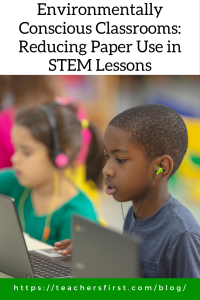The Sustainable Development Goals (SDGs) are a global to-do list for improving the world by 2030. The seventeen goals address different aspects of sustainable development, ranging from poverty to gender equality. Goal 13, climate action, addresses the need to confront climate change head-on, urging all of Earth’s citizens to cut down on greenhouse gases, prepare for climate-related disasters, and do our part now to reduce the ever-increasing impacts of climate change. It’s a reminder that we’re all in this together and must work as a team to protect our planet for the future.
We can combat climate change and its impacts on society by composting, recycling, buying eco-friendly products, taking public transportation, and reducing the use of paper. Using less paper is an achievable and worthy goal for all classrooms, and digital tools offer an easy alternative to pencil and paper tasks like worksheets, flashcards, and assessments. Moreover, integrating technology into these activities makes them accessible to students on any device at any time, facilitating continuous learning in school and beyond.
Teach Engineering Resources for K-12 (reviewed here) offers STEM lessons for all grade levels, including 332 activities, lessons, units, maker challenges, and other ideas for climate change instruction. You can find them by searching “climate change” and adjusting filters for grade level, subject area, time required, and engineering category, or by hovering over Popular Topics on the main navigation, clicking All Popular Topics, and clicking Climate Change to find materials that include curricula for grades 3–12. While all of these teaching ideas are excellent, we can enhance them and make them more environmentally friendly by making substitutions for the pencil and paper activities they often suggest. Let’s look at how we can use technology to adapt “What’s Air Got to Do With It? Properties and Quality,” a lesson for grades 3–5.
- The introductory activity provides a printout where students match common phrases about air with its meaning. As an eco-friendly alternative to printing the document for each student, use Nearpod (reviewed here) to create a matching pairs activity. Share this example with students as a schema activator as you use the questions provided to introduce your lessons on air pollution and climate change.
- Use Diffit (reviewed here) tosummarize, identify key vocabulary terms, and create questions for the air pollution and health effects readings included in the lesson. Diffit can export the material it generates to free activity templates that update monthly. For example, this reading and vocabulary workbook activity guides students through the air pollution reading document by providing several options for analysis, note-taking, and discussion. You can share what you’ve generated with students by uploading it to Google Classroom, opening it as a Google Doc, or downloading it as a PDF or Microsoft Word document.
- Instead of printing the flashcards included with this lesson, create digital flashcards using Quizlet (reviewed here). Download the flashcard document to your device, then upload it to Quizlet’s flashcard creator. Use this example to practice the terms from the lesson and extend learning by selecting other activities like a matching game and Q-chat from the dropdown box on the page. Q-Chat is an AI tutor that provides personalized quizzes, teaches information about the content in the flashcards, and asks questions that allow students to apply their knowledge of the topic.
Addressing climate change is a worldwide problem, and schools are just one small piece of the global puzzle; fortunately, we can take small steps to be part of the solution. Using digital tools in the classroom helps reduce our environmental footprint while still providing engaging, high-quality instruction. As educators, we are responsible for modeling sustainable practices, especially when teaching lessons about climate action.
What suggestions do you have for addressing SDG 13 in your classroom? Share your ideas in the comments so we can learn together.


